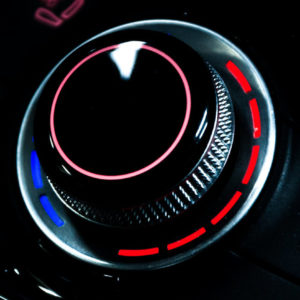Causes of Frozen A/C Pipes
First, a note about outside moisture: since ambient temperatures directly affect refrigerant pressure (and by extension, refrigerant temperature), the suction line will typically be sweaty (like a glass of iced tea) in the summer and actually may form frost in the winter if you’re using the defrost, which energizes the A/C compressor so the evaporator can dry the air before it passes through the heater core.
This is particularly true when humidity levels are high. Frost on the suction line may not even be a problem if your A/C is otherwise working normally. But below, let’s look at times when this might be an issue.
Here are the most common reasons why your car’s A/C lines are frozen:
Low-Pressure Switch Issues
Your car’s low-pressure switch monitors the low-pressure side of your A/C system. Its main function is to cycle the compressor to prevent evaporator icing. Once there’s an issue with this switch, your compressor’s operation will be interrupted. This can cause your A/C lines to ice up.

Clogged A/C Condenser
Once your A/C condenser is clogged, the A/C evaporator will struggle to transfer heat, causing the condenser itself and the lines attached to it to become extremely cold.
Leaves and other road debris can clog your A/C condenser and obstruct airflow within the system. That’s why it’s important to have your A/C condenser cleaned from time to time. If you notice that your car’s A/C isn’t operating at peak performance, it can be time to have your A/C inspected and cleaned by a professional.
Dirty Cabin Air Filter
A dirty cabin air filter can also obstruct airflow. Once this filter is clogged or filled with dirt, airflow across the evaporator can be blocked, and your A/C lines can also get iced up.
It’s recommended to replace your ride’s cabin air filter (if your vehicle has one) every year or every 12,000 miles. If you’re not sure when to change it, you can check your owner’s manual.
What to Do With a Frozen A/C Pipe

If one or several of your A/C pipes are frozen, and your A/C isn’t working properly, you have to figure out what’s causing the issue. And if you’re not a seasoned DIYer, it’s best to take your ride to an auto repair shop. But again, if your A/C is working the way it should, don’t worry about frost on the A/C lines.
A mechanic will usually inspect your A/C system for refrigerant leaks. Once your mechanic finds the root cause of the issue, you may need to replace certain A/C components like the O-rings, evaporators, and pipes. Note, however that low refrigerant won’t cause the A/C pipes to freeze. They’ll actually be warmer than they should be, not colder.
If you’ve recently been involved in a collision, and your A/C system has been exposed for more than a few hours, the receiver-dryer must also be replaced. This component can become saturated if exposed to the air for too long.
Can Frozen A/C Pipes Damage Your A/C System?
The short answer is no. A/C systems have pressure switches to interrupt compressor operation and prevent system damage when pressures are too low or too high in the system.
Signs that Your Car’s A/C Needs Servicing
Even if there’s a recommended maintenance interval for your car’s A/C system, you don’t have to wait that long if you notice something that might be wrong with your vehicle’s air conditioning.
Here are some of the most common signs it’s time to take your ride to an auto repair shop:
Strange Odor
If you notice a strange smell coming from your car’s A/C vents, it’s a tell-tale sign there’s something wrong with your A/C system. Mold, mildew, and leaks within the system may cause it to produce a strange odor.
Fluctuating Temperature
Your car’s A/C should be able to maintain a comfortable temperature inside your cabin. Faulty A/C components can cause temperature fluctuations. In some cases, your A/C may not be able to blow cool air into your cabin.
Any information provided on this Website is for informational purposes only and is not intended to replace consultation with a professional mechanic. The accuracy and timeliness of the information may change from the time of publication.




























